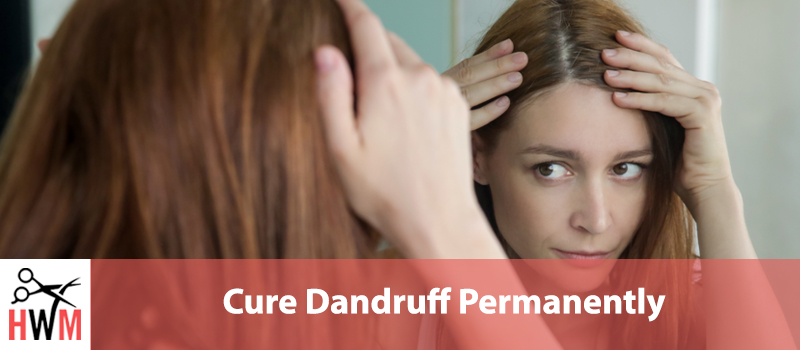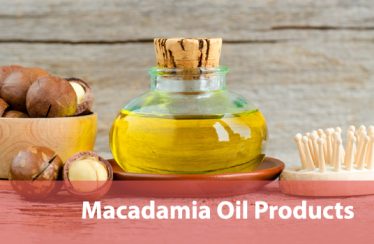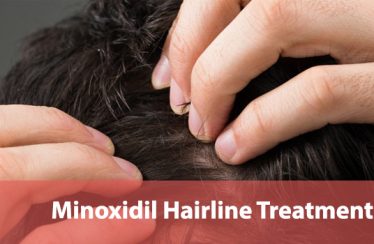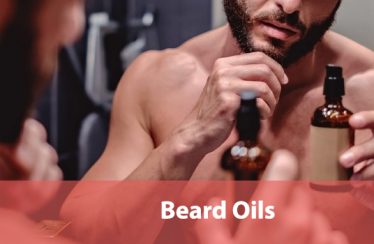Most of us have experienced it. You get dressed up, feel like you’re looking good, right up until you notice that light dusting of tiny white flakes decorating your shoulders.
Of course, now you have two options. Go change into something that will hide the dandruff flakes, or spend the evening trying to subtly brush off your shoulders and top before anyone can notice.
The next day you go out and buy a bottle of anti-dandruff shampoo. It works for a while. But you stop using it eventually, switch back to your normal shampoo, and it only takes a couple of weeks before you’ve got white flakes decorating your shoulders again.
Don’t worry. The cycle doesn’t have to continue. You can get rid of your dandruff, permanently. In this article, we’ll outline how. We cover immediate treatments and changes, to long term options that will keep your scalp clear and itch-free.
What Is Dandruff
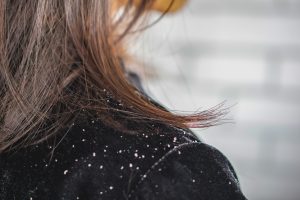
Before we get into how you can effectively treat and cure dandruff, it’s important to understand why these methods work. To fully understand, you need to know where dandruff comes from.
Many people think that dandruff is simply a sign of a dry scalp.
That’s true, up to a point. If you have dry skin and a dry scalp, that can make your dandruff worse. But dry skin alone isn’t likely to cause noticeable dandruff.
Instead, most dandruff is caused by an overgrowth of yeast on your scalp, either Malassezia or sometimes Candida. These yeasts can also be one culprit behind a more severe form of dandruff, seborrheic dermatitis.
Other skin conditions like eczema and psoriasis can also contribute to dandruff and may require additional, separate treatment.
You should also know that dandruff is not limited to your scalp. You can get dandruff almost anywhere with thick hair growth, including under chest and back hair, the groin area, and even your eyebrows.
You can’t treat all those areas with the same treatments you use on your scalp, so it takes more than just a dandruff shampoo by itself to address the root causes of dandruff.
Dandruff is also more common in men than women, for reasons that aren’t entirely clear. If you have dandruff in one location, like your scalp, you’re more likely to develop dandruff elsewhere on your body.
To get the best results, and permanently eliminate dandruff, you’ll need a combination of immediate treatments, long-term treatments, and lifestyle changes. We’ll outline several options in each category.
Choose what you think will work best for you and your current lifestyle, at least one thing from each category, and maybe several, and work to incorporate them into your life. You’ll quickly eliminate your dandruff, and so long as you stay on top of your new routine, it will stay gone, permanently.
Treating Dandruff
Before we get started, if you have particularly severe dandruff, or other forms of scalp irritation, consult with a doctor or dermatologist before making major routine changes.
They’ll be able to help you target which options will work best for your specific type of dandruff and may also offer pharmaceutical assistance in the most severe cases.
But if your dandruff and itchy scalp are less severe, you can incorporate these changes right away. We’ve tried to pick mostly all-natural options and approved anti-dandruff shampoos to minimize the risk of allergic reactions or irritating sensitive skin.
Immediate Treatments
When you have dandruff the promise of long-term benefits isn’t nearly as appealing as immediately addressing the problem.
Fortunately, there are some things you can do to help spot-treat dandruff that is immediately effective. Having a few of these dandruff fighting tools available is important, especially in the first few weeks and months of treating dandruff.
Anti-Dandruff Shampoo
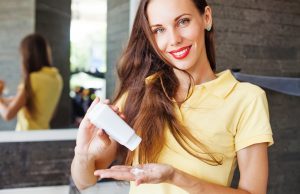
Even if you don’t use this shampoo all the time, it’s a good idea to keep a bottle or two of anti-dandruff shampoo around. When you first start the process of treating your dandruff, you should plan to use this shampoo in the week before major events and engagements.
You can also use it once or twice as an immediate treatment for mild dandruff as you get further into the process.
Anti-dandruff shampoo comes in a few varieties. Many contain zinc or ketoconazole, which both work to address dandruff by directly reducing the yeast and other microbes living on and in your scalp. Selenium sulfide, a slightly less common ingredient, does the same thing.
Coal tar, another dandruff fighting ingredient, does the same. However, it also works by slowing the turnover of new skin cells, keeping your existing skin cells healthy longer, so they don’t shed as quickly. Coal tar is a good option if your dandruff causes scaly patches of skin to form on your head.
Salicylic acid is another common ingredient, both for dandruff shampoos and normal skincare products. It’s an anti-acne treatment that helps prevent oily buildup and dead skin cell blockages from forming in your skin. Since those areas are breeding grounds for the harmful yeast and bacteria that cause dandruff, eliminating them goes a long way toward reducing your dandruff.
We mention all these ingredients because one way to make sure you’re getting the most out of anti-dandruff shampoo is to change which active ingredients you’re using. Alternate what type of shampoo you’re buying to prevent your scalp from developing a tolerance to the treatment, reducing its effectiveness.
Some good shampoo options include T-gel which uses coal tar as its primary active ingredient, Nizoral which uses ketoconazole, and Redken Brews Anti-Dandruff for Men which uses zinc.
We’ll talk a little more about common anti-dandruff shampoo ingredients like tea tree oil later on.
Salt Scrub
Another option, and a better option if you need to deal with dandruff the same day as an event or important occasion is gently scrubbing your scalp with salt.
Some people just use plain old table salt for this. The salt works as an anti-microbial, while also gently exfoliating away the loose skin flakes that would otherwise end up on your shirt.
You can also use Epsom salts, salt mixed with a small amount of oil, or mixed with herbs or spices for a gently pleasant scent. Oils can help calm itching, while spices like cinnamon and clove help soothe your scalp and numb it slightly while adding additional anti-microbial effect.
It doesn’t take much. A couple of teaspoons poured into your hands can work down to your scalp and take care of the problem. If you’re applying the salt scrub to wet hair, you’ll need little or no extra moisture. Rinse your hair after lightly scrubbing your whole scalp.
If you’re adding oil, plan on showering after you use the salt scrub.
To apply a salt scrub to dry hair, add a very small amount of water to make it easier to work the salt through your hair down to your scalp. Rinse your hair after you’re done.
Baking Soda Scrub
Another common household item you can use as a scalp scrub for immediate treatment of dandruff is baking soda. Baking soda is a little gentler than salt, making it a better option if you have sensitive skin or only very mild dandruff.
Baking soda also acts as a volumizer and cleanser, so you can skip shampoo after using a baking soda scrub.
Put a small amount of baking soda in a small bowl or directly in your hand. Add a little water at a time until you have a white paste. If the baking soda starts to dissolve into the water, add a little more baking soda until you don’t have any clear liquid left.
Work this paste through your hair down to your scalp and scrub lightly for a few minutes. The baking soda will also help reduce any itchiness or irritation from your dandruff.
Always plan on taking a shower after using a baking soda scrub. You can even use this scrub in the shower itself. Just be careful not to get too much water on your hair while you’re using it or it’ll wash away.
Apple Cider Vinegar Rinse
We’ll talk more about apple cider vinegar in the long-term section, but for very mild dandruff it can also be a spot treatment.
Mix vinegar and water 50/50 in a spray bottle and spray the vinegar lightly in your hair. You can also add a few drops of lavender, eucalyptus, tea tree, spearmint, or lemongrass essential oils to boost the effectiveness of the vinegar.
You don’t need to spray much on your hair but do use your fingers to work the vinegar solution down to your scalp.
After you’ve worked the vinegar through your hair you can either leave it to dry or let it sit for 10 minutes and rinse it out. If you decide to let the vinegar rest in your hair, don’t worry, the smell goes away as soon as your hair is completely dry.
Long Term Treatments
Long term treatments are where you get the real effectiveness. Instead of spot-treating dandruff for special occasions or to reduce itchiness and discomfort, these options will reduce and eventually eliminate the yeast and bacteria that cause dandruff in the first place.
We call these long-term treatments because, unlike the lifestyle changes we’ll discuss next, these are all targeted at reducing the bacteria directly, but won’t necessarily reduce your risk factors for getting an overgrowth of the bacteria again.
Fortunately, you can keep these steps up however long you want. Many of these options have other great benefits for your hair and scalp.
Once these are part of your normal routine, you may not want to give them up, even once your dandruff is gone for good.
Tea Tree Oil
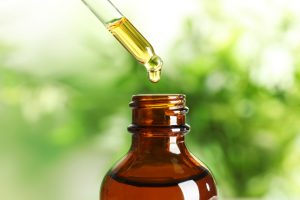
Tea tree oil is one of the better anti-dandruff treatments. It works in a few ways. For one thing, tea tree oil is an anti-microbial. It’ll reduce the levels of yeast and other potentially harmful microbes but will still leave healthy levels of those microbes alive to do their jobs.
However, you shouldn’t apply tea tree essential oil directly to your skin because it can be irritating if it isn’t diluted. Essential oils are high concentrations of the natural chemicals and compounds contained in plants.
Instead of applying it directly to your skin, you should dilute a couple of drops of tea tree oil in a carrier oil like olive, coconut, or jojoba oil.
You can also put a couple of drops of tea tree oil in a vinegar-water mixture to use as either a hair rinse or a spray.
Tea tree oil can also help encourage healthy hair growth by stimulating circulation in your scalp.
Or, if you don’t want to add an extra step to your hair care routine, put a few drops in your shampoo and conditioner. Don’t add more tea tree oil to a shampoo or conditioner that already has it listed as an ingredient, but you can add other oils we’ll talk about in a moment.
Vinegar Rinse / Spray
You can use any vinegar to fight dandruff, all of them will help balance the PH of your scalp, kill microbes, and create a less favorable environment for yeast. But apple cider vinegar is the best for your hair since it also works as a mild conditioner and can improve the health and volume of your hair.
Vinegar rinses also add extra shine to your hair, making it look healthier.
Straight apple cider vinegar is a little strong for most people and can irritate sensitive skin over repeated use. However, you can mix the vinegar with water or green tea (which we’ll talk about in a moment) to dilute it.
You can also mix in essential oils, steep fresh herbs in your vinegar mix, or add orange peels or spices for scent to further customize your vinegar rinse and get better results.
To apply it, either rinse your hair with a cup of your vinegar mix after you shower, rinsing again with plain water is optional, or add it to a spray bottle and apply up to once daily. Some people like to use a vinegar rinse every day, others spray vinegar on for 10 minutes to an hour before showering and only use it the days they shower.
Which schedule you use and how you apply the vinegar rinse is up to you. Feel free to experiment and see what works best for your lifestyle and scalp.
Green Tea Rinse / Spray
Green tea is another option to help create a healthy scalp and improve the overall appearance of your hair. Green tea is not as strongly anti-microbial as vinegar, but they can be mixed together, and green tea is a gentler option for those with sensitive skin.
Unlike vinegar, you don’t need to dilute green tea to use it as a rinse or a spray. However, you do need to brew green tea almost every time you want to use it since it will lose effectiveness when stored.
If you use green tea as a daily spray application you can probably get away with only brewing fresh every other day, but if you go longer than one day between applications you should just brew fresh.
Fortunately, any green tea you don’t need for your hair, you can drink! Drinking green tea regularly can also help improve the appearance of your skin and hair.
Other Herbs
Like tea tree oil, there are many fresh herbs and essential oils you can use as a long-term treatment for dandruff.
Almost all these herbs work by reducing yeast levels and creating a healthier environment on your scalp. You can create herbal rinses with fresh herbs or a few drops of essential oil. Or, using a carrier oil, you can create a hair and scalp mask with a few drops of essential oil.
Many of these herbs also encourage hair growth, mostly by providing essential nutrients, conditioning your hair to reduce breakage, and encouraging circulation in your hair follicles and scalp.
Some spices, like cinnamon and cloves, can also be useful, although most will just add a pleasant scent to your rinse or mask.
Lemon Juice
Another at-home long term treatment is applying a couple of teaspoons of lemon juice to your hair 1-2 times a week.
Fresh lemon juice is best, but you can use store-bought lemon juice if you need to. Don’t use anything with added sugar, since the sugar can feed the yeast and make the problem worse, not better.
Simply apply the lemon juice as a rinse and work it down to your scalp. If you don’t want the lemon juice to gradually lighten your hair, rinse it out with water after about 10 minutes.
Lifestyle Changes
At the end of the day, if you want to permanently get rid of dandruff so you don’t have to deal with these short- and long-term treatments, you need to make lifestyle changes. Fortunately, the changes you need to make to effectively eliminate dandruff are easy.
Don’t Wash Your Hair Too Often, Or Too Little
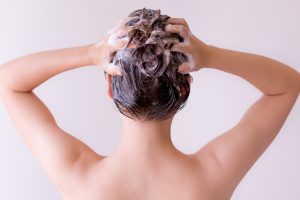
If you wash your hair every day and have dandruff, it’s time to make a change. If you only wash your hair once a week and have dandruff, it’s time to make a change.
Shower however often you want, just don’t get your hair wet. But most people benefit from washing their hair only 2-3 times a week.
Washing too often strips your natural oils and upsets the PH balance of your skin, leaving it vulnerable to microbes.
Washing too little lets oil and dead skin build-up on your scalp. The yeast and bacteria that cause dandruff see these oily patches as food. Too much oil and dead skin creates ideal conditions for them to live and multiply.
Experiment to find a washing schedule that works for you and stick to it. The occasional extra shower for a special event is okay but try not to disturb your routine too much.
Add Probiotics
Another easy but important lifestyle change is adding regular probiotics to your diet. There are lots of probiotic supplements available.
If you choose to go the supplement route look for supplements that have at least 10,000 live IU. Ideally your probiotic should also include 3 or more different probiotic cultures since each culture does a different thing.
Alternatively, you can add probiotic foods to your diet. Fermented foods like tempeh, kefir, sauerkraut, and kimchi are all good options. Yogurt and other probiotic foods are usually labeled, making them easier to find in the kitchen.
Eat More Fish
Your hair and scalp need a lot of omega 3’s to be healthy. Fish are an excellent source of omega 3’s along with other essential nutrients.
Incorporating fish into your diet can help you prevent and heal dandruff from the inside out.
Omega 3 fatty acids also help to regulate your natural oil production. So if you have a naturally oily head, adding fish (and maybe an omega 3 supplement) to your diet can help reduce excess oil production in your scalp.
It can also reduce inflammation, which is key in treating dandruff complicated by eczema or psoriasis since inflammation is a key part of those disorders.
Reduce Stress

Reducing stress seems to come up in almost every health-related discussion. While it can be tiring to hear it again, there’s a reason stress is such a common topic.
Stress can leave your body vulnerable to infections, increase inflammation, and make it easier for your skin and other tissues to be irritated. All that leads to increased dandruff.
Some stress is unavoidable, and if you have a serious stressor like a car crash, the death of a loved one, or ongoing problems at work, you should expect to see a little more of the white flakes. But reducing stress can be a major factor in getting rid of your dandruff permanently.
Try incorporating mindfulness practices, meditation, and gentle exercise to reduce stress. It can also be helpful to give yourself a guaranteed self-care ritual every day.
Maybe it’s brushing your beard or making and drinking your favorite coffee. Or maybe it’s half an hour working on your favorite hobby or playing a video game.
Whatever works best for you, reducing stress will help you eliminate your dandruff, and will help you enjoy and get the most out of your day to day.
